In response to readers’ comments about the legal status of metric units on British roads, Ronnie Cohen has written a summary which he hopes will clarify the situation.
The rules for road traffic signs are governed by the Traffic Signs Regulations and General Directions (TSRGD) 2016. This is the most recent version of the TSRGD. It came into force on 22 April 2016. The TSRGD 2016 allows metric units on the following signs:
| Sign(s) | Diagram | Description |
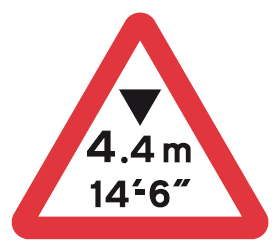 | 530A | Maximum headroom available at hazard, with height indicated in both metric and imperial units. (On this sign, maximum vehicle height must be shown in metres and in feet and inches.) |
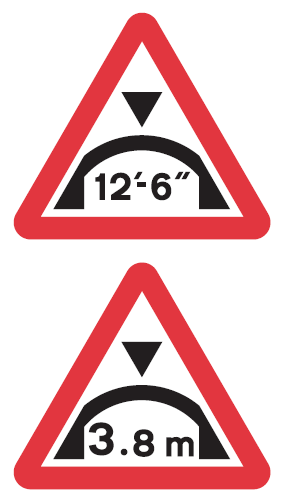 | 531.1A | Maximum headroom available at arch bridge ahead. (Two triangular signs with arch bridge images must be shown together, one in metres and the other in feet and inches.) |
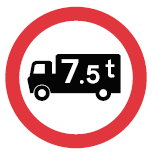 | 622.1A | Goods vehicles exceeding the maximum gross weight indicated prohibited. (The weight limit for vehicles is shown in tonnes on this circular sign.) |
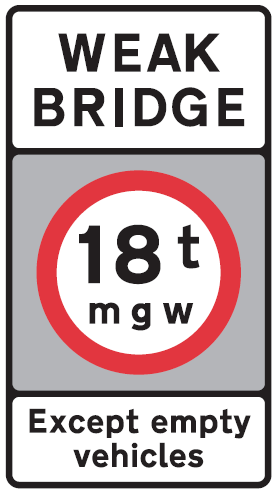 | 626.2A | Vehicles exceeding the maximum gross weight indicated prohibited from crossing the bridge or other structure with exemption for empty vehicles. (MGW is shown in tonnes.) |
 | 629.1 | Vehicles or combinations of vehicles exceeding the length indicated prohibited. (Two circular signs with lorry and length arrow images must be shown together, one in metres and the other in feet and inches.) |
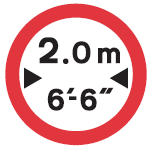 | 629A | Vehicles exceeding the width indicated prohibited in both metric and imperial units. (On this sign, maximum vehicle width must be shown in metres and in feet and inches.) |
 | 629.2A | Vehicles exceeding height indicated prohibited with height indicated in both metric and imperial units. (On this sign, maximum vehicle height must be shown in metres and in feet and inches.) |
 | 779 | “Safe height” and numerals indicating height in imperial units and, in brackets, the height in metric units, with or without “load gauge”. |
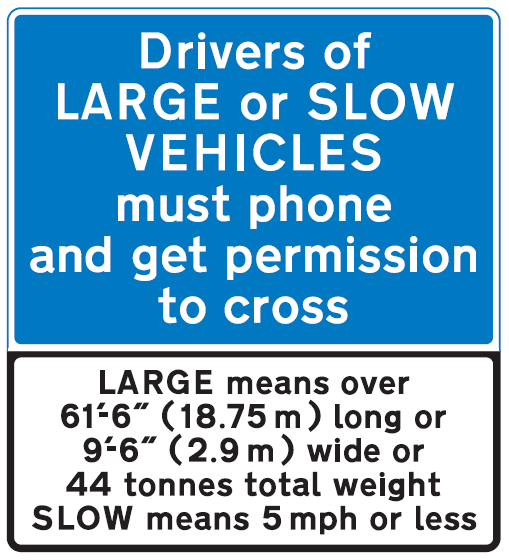 | 784.1 | Drivers of large or slow vehicles must stop and telephone in accordance with the provisions of paragraph 6 of Part 7 before using a level crossing. (This sign shows maximum vehicle height and width in feet and inches followed by metric conversions in brackets, total weight in tonnes and speed limit in miles per hour.) |
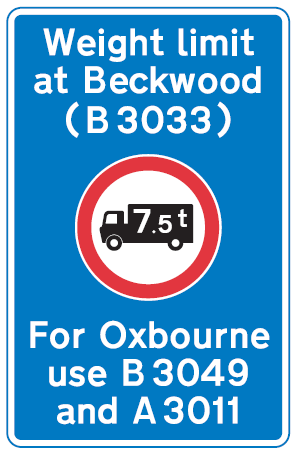 | 818.4 | Nature and location of a prohibition, restriction or requirement with indication of alternative route. (This sign shows a weight restriction in tonnes.) |
 | 818.5 | Location of a low bridge with indication of alternative route. (This shows a height restriction in metric and imperial units.) |
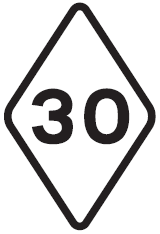 | 976 | Maximum speed limit for tramcars in kilometres per hour. (This is the only metric speed limit in the TSRGD and is only intended for tram drivers.) |
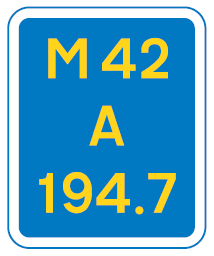 | 2718 | Route number and location reference. (This is a driver location sign that shows the motorway, a letter and the number of kilometres from the start of the motorway. Only the number is shown without any unit symbol or abbreviation.) |
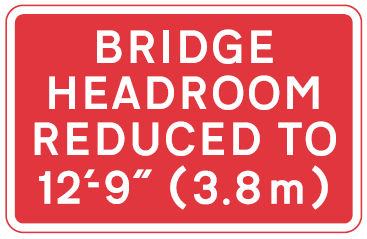 | 7014.1 | Temporary or permanent reduction in bridge headroom ahead. |
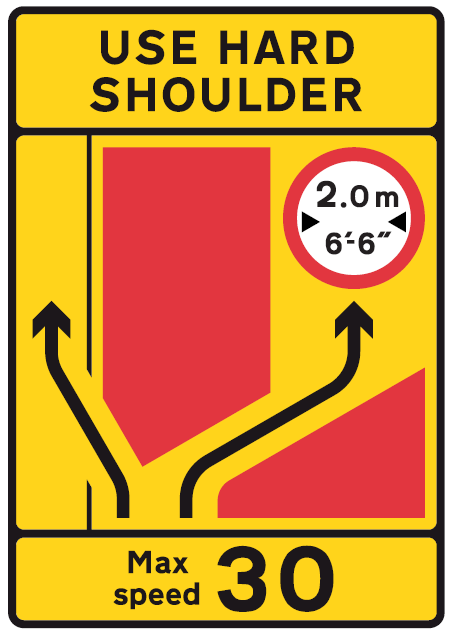 | 7243 | Temporary road layout with lane restrictions. (This shows a width restriction ahead in metric and imperial units.) |
  | Lorry symbols showing tonnes are used with other signs to indicate restrictions for goods vehicles over the maximum gross weight shown. No diagram numbers are assigned to them in TSRGD 2016. |
Since at least 1980, motorways have had distance marker posts installed at 100 metre intervals alongside the hard shoulder. These show the distance in kilometres to one decimal place from the start of the motorway .
All distances shown on traffic signs in the TSRGD must be shown in yards, miles or fractions of a mile. There are no exceptions to this rule for any signs in the TSRGD.
All speed limits, except those for tramcars, must be shown in miles per hour. The speed limit for tramcars is shown in kilometres per hour in the TSRGD. This is the only metric speed limit in the TSRGD.
There are just 15 official diagrams in all 547 pages of the TSRGD that allow the use of metric units. For a road traffic sign to be lawful, it must be either prescribed in the Traffic Signs Regulations and General Directions or be authorised by the Secretary of State for Transport. The Secretary of State for Transport can authorise new traffic signs by Statutory Instrument. That is how new metric signs can be introduced on British roads. These new signs would be legal. For example, the new metric social distance signs for pedestrians were authorised in this way.
It is possible for local authorities, private individuals, businesses and organisations to obtain consent under the Town and Country Planning (Control of Advertisement) Regulations to erect signs. All such signs are defined as “advertisements” for the purposes of the Town and Country Planning Acts. Signs conforming to the TSRGD do not require separate consent under the Advertisement Regulations – this has given rise to confusion regarding which signs are “legal” and this confusion has been exploited by those opposed to metric signs in any form. Signs authorised under the Advertisement Regulations can show metric – or indeed any other – units. The Planning Authority cannot refuse consent because of the measurement units which appear on the signs.
Thus it is possible for drivers to come across private signs that show the distance in metres to nearby facilities and exclusively metric height signs at, for example, petrol stations and off-street car parks. These are not official road traffic signs and are therefore governed by the requirements of the Advertisement Regulations, not the TSRGD.
For more information, see the following web pages on the UKMA website:
- https://ukma.org.uk/road-signage/
- https://ukma.org.uk/road-signage/are-metric-signs-legal/
- https://ukma.org.uk/road-signage/are-metric-signs-legal/detailed-analysis/
You can find a copy of TSRGD 2016 in PDF format at https://tsrgd.co.uk/pdf/tsrgd/tsrgd2016.pdf.

What a muddle, added to the tragicomedy of this whole farrago, is the fact that all new roads built using metric units. Added to this, the distances to junctions that are displayed in fractions of a mile or a “300 yard” countdown are actually metres converted to the nearest yard with a 10% tolerance.
The real icing on the cake here though, is that all the dimensions for font, placement and dimensions for building the sign are in metric.
LikeLike
John Smith points out yet another good reason (the underlying distance in metric) for at least converting all distance signs to metric only without delay. Maybe someday?
LikeLike
“All distances shown on traffic signs in the TSRGD must be shown in yards, miles or fractions of a mile. There are no exceptions to this rule for any signs in the TSRGD.”
So this answers the question concerning the legality of metric units used on distance signs. This is where the law has to be changed to allow for legal metric distance signs. It may be almost impossible at this time to have the law changed to show metric only signage, but allowing for metric on signs should be made legal.
Is there a reason why miles, yards and fractions of miles are the only legal units allowed?
LikeLike
I am concerned about the term ‘metric conversions’ in reference to the warning signs for large or wide lorries wishing to cross a level crossing. Modern lorries are all built to metric measurements, so surely it is the imperial figure on the sign that is a ‘conversion’. To my mind it would make more sense to put the metric figure first, followed by the imperial conversion in brackets, not the other way round, if an imperial figure is still considered necessary.
LikeLike
Just watched the live Internet stream from Sky News this morning where their reporter showed the celebration in the Irish town where Joe Biden’s ancestor left in the 1850’s to come to America. The locals talked about Biden’s commitment to the Good Friday agreement, which they also ardently support. No surprise there.
What also did not surprise me (but also heartened me) was to hear and see a young woman talk about how crucial it was that the Good Friday agreement continue to be observed since (as she put it) “we are only 11 kilometres from the border”.
I am certain it was the conversion of road signs that shifted the Irish mentality to think of distances (and speeds) in metric. The same thing happened in Canada back in the 1970’s and to this day Canadians always use metric for longer distances and for speeds despite their own significant metric muddle because they sit right on top of their mostly Imperial (sadly) USA.
I still remain hopeful that I will live long enough (having turned 70 this past Spring) to see the road signs converted to metric in the UK (0r at least in Northern Ireland and Scotland if Brexit winds up breaking up the UK due to a border poll in Ireland approving unification and an IndyRef2 getting approved in Scotland at some point in the near-ish future).
Who knows? Anything can happen!
LikeLike
As far as I know, Scotland could changeover to metric signs right now if they chose to do so. Traffic signs and speed limits are a devolved power.
LikeLike
@Modernman
No wonder Boris Johnson thinks devolution is a “disaster”!
😉
LikeLike
Modernman:
Traffic signs and speed limits may be a devolved power, but I don’t believe the units used to express them are.
LikeLike
Today I read a review of a rather sporty new car in one of the newspapers. The car’s width was given as 2189 mm. Had it been 1989 mm, I wondered whether or not the standard width limit in roadworks etc of 2 metres/6ft 6in would apply. Clearly 1989 mm is less than 2 metres, but is more than 6ft 6in (1879 mm).
LikeLike
Jake:
Units and standards of weight and measurement are reserved (Section C9, Schedule 5, Scotland Act 1998), but that reservation applies to the _definition_ of the units – ie, the Scottish parliament couldn’t legislate to change the definition of the metre, nor could it legislate for a new unit of length called the scotmetre.
The reservation also extends to the regulation of trade so far as involving weighing, measuring and quantities, but I think it would be pretty hard to argue that the units used for speed limits relate to the regulation of trade.
I therefore see no reason why Scottish ministers couldn’t legislate for speed limits to be in km/h in Scotland.
LikeLiked by 1 person
Martin Vlietstra… 6’6″ in real money is 1981mm in silly money. Please learn maths before jumping on the new is good bandwagon…
LikeLike
Kenneth wrote “I think it would be pretty hard to argue that the units used for speed limits relate to the regulation of trade”
I don’t understand why different units should be not only acceptable but necessary for different types of measuring. For example, if I buy a length of material, it is measured by the metre, but if I travel a length of distance on the road, it is measured by the yard. A length is a length. Why different units for the measurement of material and the measurement of tarmac on the road. I admit I am not ‘buying’ the tarmac’ (I have already paid for my right to use it as the legal owner of a road vehicle), but it is the principle of the measurement of length.
LikeLike